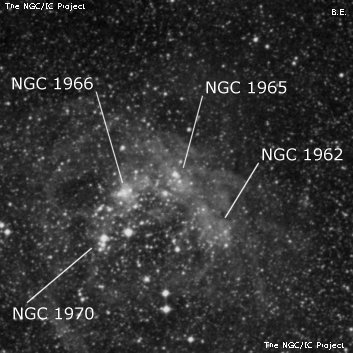
John Herschel discovered NGC 1965 = h2867 = D 136? on 31 Jan 1835 and recorded "F, S; the second of a group of four nebulae [with NGC 1962, 1966 and 1970] with stars. The place interpolated from those of the 1st and 3rd by aid of a diagram made at the time. Plate VI, figure 20."
Herschel noted Dunlop 136, discovered on 25 Sep 1826 probably includes h2867. James Dunlop wrote, "a faint confused pretty large nebula. There are a multitude of small nebulae in this place." Dunlop's position is ~10' too far SW (typical error), though he did not distinguish the individual components of the complex, at least in his published description. The entire group was also sketched by Joseph Turner in Dec 1875 using the 48" Great Melbourne Telescope (plate III.30 at www.docdb.net/history/texts/1885osngmt________e/lithograph_m_3_30.php)
600/800mm - 24" (4/7/08 - Magellan Observatory, Australia): this is a bright, small knot on the NW side of a large HII complex and cluster (association LH 58) that includes NGC 1966 (1.5' ESE), NGC 1962 (2.2' SW) and NGC 1970. NGC 1965 surrounds two stars and ~20" in diameter with a fainter nebulous halo.
Notes by Steve Gottlieb